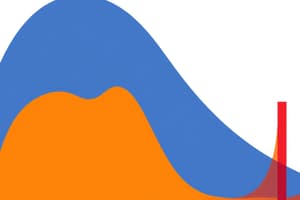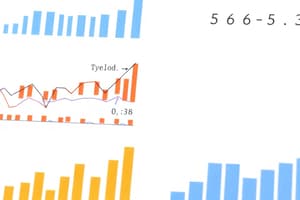Podcast
Questions and Answers
What does descriptive statistics primarily focus on?
What does descriptive statistics primarily focus on?
- Conducting experiments to gather data
- Making predictions based on data
- Analyzing relationships between multiple variables
- Collecting and describing numerical information (correct)
Which of the following accurately describes the median?
Which of the following accurately describes the median?
- The sum of all values divided by the number of values
- The highest value in the data set
- The midpoint in a distribution of values (correct)
- The most frequent value in a data set
What is the purpose of a frequency distribution?
What is the purpose of a frequency distribution?
- To identify outliers in a distribution
- To display the variation within a set of values
- To show the average value of a data set
- To provide the number of people in each category of a variable (correct)
Which measure describes the spread of values around a mean?
Which measure describes the spread of values around a mean?
In a contingency table, what is typically shown to identify relationship strength?
In a contingency table, what is typically shown to identify relationship strength?
What does bivariate analysis examine?
What does bivariate analysis examine?
Which of these accurately defines variance?
Which of these accurately defines variance?
What does a smaller standard deviation indicate?
What does a smaller standard deviation indicate?
Which of the following is NOT a type of descriptive statistic?
Which of the following is NOT a type of descriptive statistic?
What is the primary function of chi-square analysis?
What is the primary function of chi-square analysis?
Flashcards
Descriptive Statistics
Descriptive Statistics
Summarizing and describing the main features of data.
Univariate Analysis
Univariate Analysis
Analyzing one variable at a time, looking at its distribution, central tendency, and dispersion.
Frequency Distribution
Frequency Distribution
A table showing the number and percentage of data points in each category of a variable.
Measure of Central Tendency
Measure of Central Tendency
Signup and view all the flashcards
Mean
Mean
Signup and view all the flashcards
Median
Median
Signup and view all the flashcards
Standard Deviation
Standard Deviation
Signup and view all the flashcards
Bivariate Analysis
Bivariate Analysis
Signup and view all the flashcards
Contingency Table
Contingency Table
Signup and view all the flashcards
Outliers
Outliers
Signup and view all the flashcards
Study Notes
Descriptive Statistics
- Statistics involves collecting, describing, and analyzing numerical information.
- Descriptive statistics describe basic data features while inferential statistics make broader conclusions.
- Univariate analysis examines a single variable.
Univariate Analysis Components
- Frequency Distribution: A table showing the count and percentage of observations falling into each category of a variable. Useful for all variable types.
- Measures of Central Tendency:
- Mean: The average of all values.
- Median: The middle value when data is ordered.
- Mode: The most frequent value.
- Measures of Dispersion: Describe how spread out the data is.
- Range: Difference between the highest and lowest values.
- Variance: Measures how closely data values cluster around the mean. Calculated by finding the average of the squared differences between each data point and the mean.
- Standard Deviation: A measure of the spread of data around the mean. A smaller standard deviation indicates the data points are clustered closer to the mean.
Data Visualization
- Diagrams used to represent quantitative data.
- Nominal or ordinal variables are displayed with bar or pie charts.
- Interval/ratio variables are displayed using histograms.
Bivariate Analysis
- Examines the relationship between two variables.
- Looks for patterns where changes in one variable correspond with changes in the other.
- Simplification: Data is often condensed for easier analysis.
- Chi-square analysis: Identifies deviations from expected category matches.
- Binary outcomes: Simplifies outcomes for easier comparison.
- Summary measures: Central tendency comparisons and correlation analysis are used to describe overall relationships between variables.
- Contingency Tables: Display the relationship between two variables, often using percentages to show the contribution of each category. These are flexible and applicable to various variable types (nominal, ordinal, interval, ratio.)
Studying That Suits You
Use AI to generate personalized quizzes and flashcards to suit your learning preferences.




